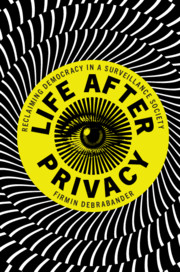Refine search
Actions for selected content:
48468 results in Computer Science
Machine learning approaches to identify and design low thermal conductivity oxides for thermoelectric applications
-
- Journal:
- Data-Centric Engineering / Volume 1 / 2020
- Published online by Cambridge University Press:
- 09 September 2020, e8
-
- Article
-
- You have access
- Open access
- HTML
- Export citation

Life after Privacy
- Reclaiming Democracy in a Surveillance Society
-
- Published online:
- 08 September 2020
- Print publication:
- 08 September 2020
3 - Big Plans for Big Data
-
- Book:
- Life after Privacy
- Published online:
- 08 September 2020
- Print publication:
- 08 September 2020, pp 37-57
-
- Chapter
- Export citation
6 - The Borderless, Vanishing Self
-
- Book:
- Life after Privacy
- Published online:
- 08 September 2020
- Print publication:
- 08 September 2020, pp 95-114
-
- Chapter
- Export citation
2 - Defending Privacy
-
- Book:
- Life after Privacy
- Published online:
- 08 September 2020
- Print publication:
- 08 September 2020, pp 21-36
-
- Chapter
- Export citation
Contents
-
- Book:
- Life after Privacy
- Published online:
- 08 September 2020
- Print publication:
- 08 September 2020, pp v-vi
-
- Chapter
- Export citation
4 - The Surveillance Economy
-
- Book:
- Life after Privacy
- Published online:
- 08 September 2020
- Print publication:
- 08 September 2020, pp 58-74
-
- Chapter
- Export citation
1 - Confessional Culture
-
- Book:
- Life after Privacy
- Published online:
- 08 September 2020
- Print publication:
- 08 September 2020, pp 1-20
-
- Chapter
- Export citation
Index
-
- Book:
- Life after Privacy
- Published online:
- 08 September 2020
- Print publication:
- 08 September 2020, pp 164-170
-
- Chapter
- Export citation
5 - Privacy Past and Present
-
- Book:
- Life after Privacy
- Published online:
- 08 September 2020
- Print publication:
- 08 September 2020, pp 75-94
-
- Chapter
- Export citation
Copyright page
-
- Book:
- Life after Privacy
- Published online:
- 08 September 2020
- Print publication:
- 08 September 2020, pp iv-iv
-
- Chapter
- Export citation
Preface
-
- Book:
- Life after Privacy
- Published online:
- 08 September 2020
- Print publication:
- 08 September 2020, pp vii-x
-
- Chapter
- Export citation
Conclusion
-
- Book:
- Life after Privacy
- Published online:
- 08 September 2020
- Print publication:
- 08 September 2020, pp 157-163
-
- Chapter
- Export citation
Acknowledgements
-
- Book:
- Life after Privacy
- Published online:
- 08 September 2020
- Print publication:
- 08 September 2020, pp xi-xii
-
- Chapter
- Export citation
Hamiltonian Berge cycles in random hypergraphs
- Part of
-
- Journal:
- Combinatorics, Probability and Computing / Volume 30 / Issue 2 / March 2021
- Published online by Cambridge University Press:
- 08 September 2020, pp. 228-238
-
- Article
- Export citation
7 - Autonomy and Political Freedom
-
- Book:
- Life after Privacy
- Published online:
- 08 September 2020
- Print publication:
- 08 September 2020, pp 115-136
-
- Chapter
- Export citation
8 - Powerful Publics
-
- Book:
- Life after Privacy
- Published online:
- 08 September 2020
- Print publication:
- 08 September 2020, pp 137-156
-
- Chapter
- Export citation
Semi-supervised machine learning with word embedding for classification in price statistics
-
- Journal:
- Data & Policy / Volume 2 / 2020
- Published online by Cambridge University Press:
- 07 September 2020, e12
-
- Article
-
- You have access
- Open access
- HTML
- Export citation
Emerging health data platforms: From individual control to collective data governance
-
- Journal:
- Data & Policy / Volume 2 / 2020
- Published online by Cambridge University Press:
- 07 September 2020, e13
-
- Article
-
- You have access
- Open access
- HTML
- Export citation







